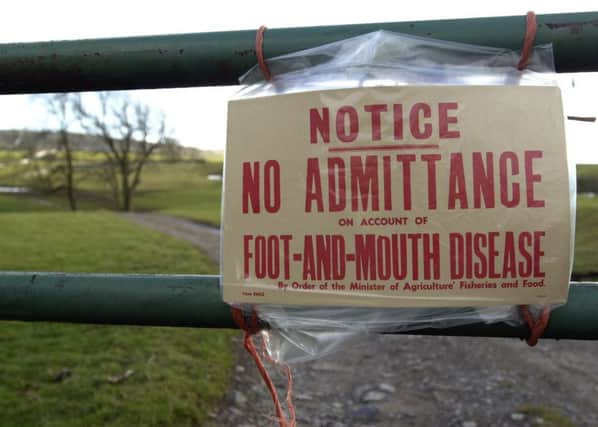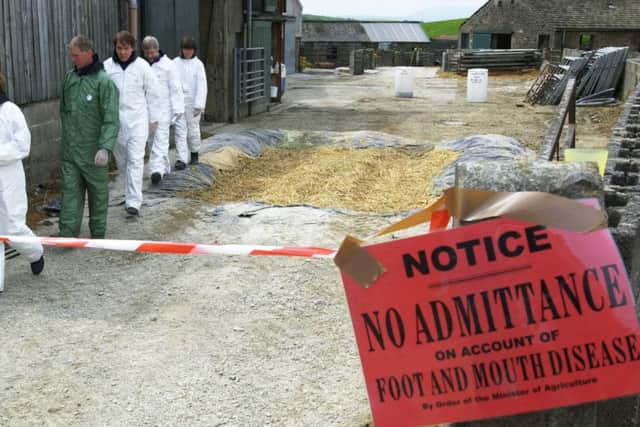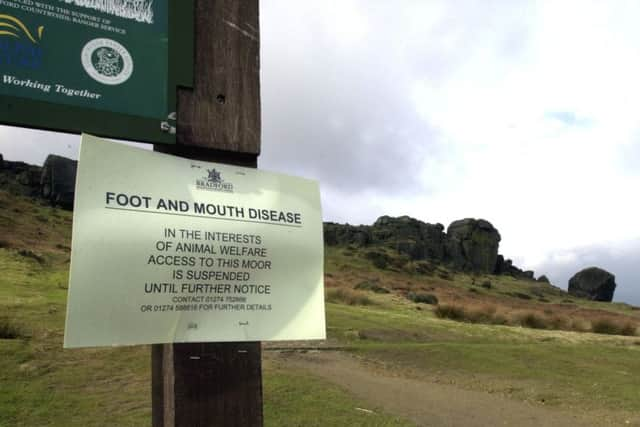Foot and Mouth: Outbreak etched in the memory 15 years on


The financial and emotional scars from one of the darkest chapters in the history of the UK farming industry have all-but healed, even if the memory of the terrible suffering the outbreak caused remains painfully raw.
In the months that followed the detection of foot and mouth in pigs at an abattoir in Essex on February 19, 2001, almost 6.5m sheep, pigs and cattle were slaughtered nationally, hundreds of farmers were driven out of business, and bloodlines that had taken generations to develop were lost or irretrievably damaged.
Advertisement
Hide AdAdvertisement
Hide AdThe conservative estimate of the impact foot and mouth disease (FMD) on the rural economy is around £8bn, a total which includes compensation to farmers and the massive damage caused to tourism in areas like the Lake District and Yorkshire Dales, which suffered huge falls in visitor numbers.


In 2016, there are few obviously visibly reminders of FMD but the 2001 outbreak has left a lasting legacy in the techniques, protocols and attitudes of farmers.
NFU chief animal health and welfare adviser Catherine McLaughlin said: “FMD has been eradicated in this country but it did change the way we farmed 15 years ago.
“We now have identification and tracing systems for our animals, rehearsed contingency plans and technological advances in disease control. However, the threat of exotic disease is ever present - the world is an increasingly smaller place and movements of animals, people and food make us all vulnerable to the introduction of diseases such as FMD, through both illegal and accidental means.
Advertisement
Hide AdAdvertisement
Hide Ad“It is important that we never forget the devastation of that time and always make sure our actions don’t cause repeat problems.”


The 2001 outbreak is widely believed to have originated from infected meat in swill fed to pigs at Burnside Farm, Heddon-on-the-Wall, Northumberland.
The FMD virus was not present in the UK in the early weeks of 2001 and with restrictions on import of meat from countries where it was present already in place, it is likely the contaminated meat had been imported illegally.
Within days of FMD being detected in pigs from Burnside Farm sent for slaughter to Essex, a total ban on the feeding of catering waste containing meat or meat products was introduced, but Pandora’s box had already been opened.
Advertisement
Hide AdAdvertisement
Hide AdOver the next few days FMD was confirmed at other farms in Northumberland and Devon, and the number of cases elsewhere rose exponentially.


In hindsight, the Government’s initial response was both inadequate and lacking in urgency, and with a general election looming in the spring of that year, farmers caught up in the outbreak became political pawns.
The imposition of severe restrictions on the movement of livestock helped arrest the spread of FMD, but caused great suffering to many farmers whose animals were not infected, including York farmer Charles Mills, now the honorary show director of the Great Yorkshire Show.
“We were fortunate not to have FMD on any of our farms but movement was a big problem for us,” he recalled. “At the time we had a lot of pigs spread across four farms and moving them was impossible.
Advertisement
Hide AdAdvertisement
Hide Ad“Many sheep farmers suffered badly because FMD struck at lambing time and they weren’t able to get their stock in. It was a nightmare.”


At the height of the outbreak, between 80,000-90,000 animals were slaughtered each week, many of them by hastily-trained soldiers, and shocking images of funeral pyres of cattle, pigs and sheep became a sickeningly common sight on TV and in newspapers.
The final case of FMD in 2001 - the 2,030th in the UK - was reported at a farm in Appleby-in-Westmorland on September 30 with the final cull taking place on New Year’s Day, 2002.
The Labour Government, which had won a General Election delayed by FMD, resisted calls for a public inquiry into the handling of the outbreak because it would be too costly and time-consuming, but three separate inquiries all fed back their findings.
Advertisement
Hide AdAdvertisement
Hide AdA common view was that the failure to learn from the lessons of the previous large-scale FMD outbreak in 1967 should not be repeated, whilst the National Audit Office (NAO) concluded that the Government’s entire crisis management strategy needed to be reviewed.
In his report from June 2002, Sir John Bourn, head of the NAO, said: “In the light of what happened, urgent action is needed to produce contingency plans which would be more sensitive to outbreaks of different scales and thus be better suited to dealing with a future crisis on this scale.
“Moreover, further research must be carried out into effective measures for tackling foot and mouth. And the means for ensuring minimum standards of cost and financial control in crisis conditions must be established. There are lessons to be learned for the whole of Government from the foot and mouth crisis.”
If, and when FMD strikes again, it is difficult to image Yorkshire’s farmers enduring a year of hell as they did in 2001.
MAJOR EVENTS FELL VICTIM
Advertisement
Hide AdAdvertisement
Hide AdSports events - Six Nations rugby union fixtures and the Isle of Man TT motorcycle race - were axed amid fears over the effects of human movement in rural areas.
For the first time since the Second World War, the Great Yorkshire Show was also cancelled. Show director, Charles Mills, said: “There was no way of moving livestock and very real dangers of spreading the virus even further by bringing farmers together for the show.”
The UK has remained largely FMD-free since 2001 - two cases reported in Normandy, Surrey in August 2007 were linked to the Institute for Animal Health at nearby Pirbright - and the farming industry and Government is clearly more switched on than it was 15 years ago.